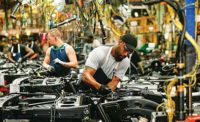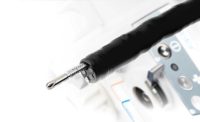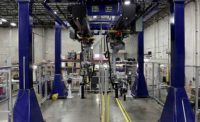Walk into any hardware store, and you’ll be hard-pressed to find tools or knives that are made in the U.S. Most are made in China or other low-cost labor centers.
Nevertheless, many knife and tool manufacturers are still surviving—nay, thriving—in the U.S. thanks to lean manufacturing, innovative design, the shrewd application of technology, and an unrelenting commitment to quality.
“We have always made our products in the U.S.,” says Jon DeArment, president and chief operating officer of Channellock Inc., a manufacturer of high-quality pliers and hand tools in Meadville, PA. “2016 will be our 130th year. We’re a fifth-generation family-run business, which says a lot about our commitment to quality and the products we make.
“Opportunities to source our products in other parts of the world have always been there, but we really believe in staying in our community,” continues DeArment, whose great-great-grandfather, George DeArment, founded the company back in 1886. “There’s a lot to be said for actually making tools vs. merely selling them. If you make a good product and sell it at a good value, you’re going to win.”
Unlike Channellock, Leatherman Tool Group Inc. does not date back to the mid-19th century. The company was founded in 1983 by mechanical engineer Tim Leatherman. But, like Channellock’s founders, Leatherman was committed to manufacturing in his hometown, in this case, Portland, OR. Indeed, Leatherman Tool Group’s 90,000-square-foot factory is not far from the garage where Tim Leatherman developed the prototype for his company’s iconic multitool.
Community development aside, Leatherman Tool sees quality control as a distinct advantage of manufacturing domestically. “We own all the critical aspects of quality right here in this one facility,” says Charles Calvin, vice president of manufacturing at Leatherman Tool Group. “Coiled steel comes in one end of the building and packaged product goes out the other end.”
Made in the USA
If offering high-quality products isn’t enough reason to get consumers to part with their hard-earned cash, domestic knife and tool manufacturers have a marketing hook that their overseas competition can’t match: the “Made in the USA” label. In a crowded, competitive market, the “Made in the USA” label can be just enough to sway even the most price-conscious consumer.
Klein Tools recently commissioned a survey of electricians to learn what they look for in the tools they buy. A family-owned and operated company, Klein Tools has been designing and manufacturing professional-grade hand tools since 1857. Based in Lincolnshire, IL, the company specializes in pliers, cutters, crimpers and other tools for electricians and telecommunications workers, and it makes most of them here in the United States.
The survey was conducted by Russell Research, an independent research firm, which performed 201 online interviews from Jan. 20-26, 2015. Forty percent of respondents were union members; 60 percent were not.
Five in six union members (83 percent) indicated that being “Made in the U.S.A.” is very important or important to them when purchasing a tool, and one-fifth (19 percent) named it the most important factor. This was significantly higher than importance among non-union members. Three in five (59 percent) non-union members indicated being “Made in the U.S.A.” is very important or important to them, and few (6 percent) named it the most important factor.
Not surprisingly, then, Klein continues to invest in domestic manufacturing. The company employs more than 1,000 workers at eight factories in Illinois, Texas, Iowa, Arkansas, Michigan and New York. In April 2014, the company opened a state-of-the-art heat-treating facility in Mansfield, TX.
Over the next few years, the company plans to invest more than $100 million so it can manufacture more tools in the U.S. that are currently imported, in addition to being able to make new products that would otherwise be imported.
“Klein Tools has been manufacturing tools in America since 1857, and it’s as important for us to keep that tradition now as it was more than 150 years ago,” says Thomas R. Klein, president of Klein Tools. “The continued investment in our plants, people and products will help us continue [that] tradition.”
Assembling Multitools
A vertically integrated factory, the Leatherman assembly plant produces more than 1 million tools each year and ships products to more than 80 countries.
The manufacturing process begins with raw steel. Eight-hundred-pound rolls of steel are fed into a servo-driven 300-ton stamping press, which punches out individual parts, such as tool handles, knife blades, screwdrivers and saws.
“We do most of our metal stamping and forming in house,” says Calvin. “A few years ago, it was half and half. Now, we design and build all of our stamping dies, from fine blanking to progressive tool stamping.”
Not all parts can be made by the punch press. Forged components, such as pruners, go through a horizontal milling process to get their shape. Premium knife blades, such as those made out of S30v stainless steel, are so strong, they must be cut using a laser cutter.
“Our products have evolved to require more and more machining,” notes Calvin. “In past two or three years, we have installed 15 or so machining centers that are all loaded automatically. We just keep them supplied with parts, keep the dimensions in check, and change the tools when required, and they will run self-sufficiently. We’ve always had a couple of machining centers, but we’ve made the leap to a lot now.”
After heat treatment to strengthen the steel, parts are placed in tumblers filled with ceramic beads to polish and deburr their edges. When they’re finished, a magnet separates them from the ceramic and collects them for transport to the next stop on the production line.
The mass finish area is where tool components are given their final touches. Saws get their teeth in a two-step process. Knives are hollow ground and sharpened. Pliers get their smooth finish from one of three six-axis robots.
“To produce knife blades, saws and files, we use the latest technology for CNC creep-feed grinding,” says Calvin. “We used to have rows and rows of old circle polishers to polish pliers, and we still do have some. But today, most of our polishing is done by robot. An operator loads parts on a track and a robot picks them up, runs them through the polishers, and places them on an outfeed conveyor.”
Once all the parts have been stamped, cut, ground and finished, they come together in the assembly area, where every Leatherman product is put together by hand. The workers here assemble 12,000 tools during an average day. Every tool and knife is thoroughly checked and inspected prior to packaging.
Assemblers use advanced, torque-controlled screwdrivers to install fasteners. Benchtop, time-pressure dispensers apply adhesives.
Calvin says Leatherman is developing automated assembly processes for some subassemblies. However, because the plant has thousands of part numbers, automation is not always practical or cost-effective.
In recent years, Leatherman has been striving to maximize the efficiency of the factory while at the same time maintaining high quality standards. A decade ago, the company launched a lean manufacturing initiative, and the entire factory was reorganized. The factory was arranged into product-family value streams with supermarkets and kanban cards.
Making Pliers
After more than a century in business, Channellock still follows the four guiding principles laid out by founder George DeArment:
- Good management is never far from the factory floor.
- People are more important than machines.
- Bigger doesn’t always mean better.
- Dedication to excellence is the surest way to surmount adversity and prosper.
Like Leatherman, Channellock is vertically integrated. Raw steel comes in; finished tools go out.
“Whenever we can, we’re looking to leverage new technology or bring in some new innovation to keep our factory competitive,” says DeArment who previously served as the company’s vice president of manufacturing and engineering. “Over the years, we’ve invested quite a bit in CNC technology and automation, focusing on labor-intensive, highly repetitive operations.”
Channellock pliers start out as rods of North American C1080 high-carbon steel.
With thousands of pounds of force, massive air-powered, computer-controlled die forgers precisely hammer microwave-heated steel into parts. Excess metal is then removed on a trim press.
From the forge, each tool element is precisely ground, drilled, counterbored, channeled, broached and polished to exact tolerances. After almost every step, craftsmen inspect each component for strength and quality.
Steel is an unpredictable material. Heat it too much and it becomes hard and brittle. Heat it too little and it remains relatively soft and easily fatigued. Channellock’s unique heat-treating processes ensure a controlled, uniform tempering that’s strong enough to withstand great force, but flexible enough to resist breakage under load conditions.
The combination of high-carbon steel and proprietary site-specific laser hardening techniques make it possible to achieve just the right metallurgical characteristics at various spots in the tool. Laser hardening allows the jaws and teeth of the pliers to be very durable, while the handles maintain flexibility for greater control.
“Heat treating is paramount,” says DeArment. “We’ve invested a lot in new technology for that, from new furnaces to site-specific hardening technologies. We use a laser-hardening operation on all the working surfaces of the pliers, such as teeth and cutting edges. It gives you a much better controlled process. You want those working surfaces to be super hard, but you don’t want the entire tool to be that hard.
“Depending on the application, whether it’s a cutting plier or a gripping plier or a tongue-and-groove plier, you’re going to want a different structure in the steel. Heat treating gives you that.”
Six-axis robots load parts into forging equipment, machining centers, heat-treating equipment, and polishing machines. “The applications for robots are limitless,” says DeArment. “Wherever we see a good fit, we try to make them work.”
In the assembly area, the two halves of a plier are joined. Solid-joint pliers are assembled with a hot-headed riveting operation. Slip-joint or tongue-and-groove pliers are assembled with a proprietary cold-headed fastener called Permalock. The fastener creates a secure joint, but also lets assemblers make adjustments to ensure that the pivot mechanism works smoothly, without excessive play or stiffness.
“By introducing the Permalock, we eliminated all the field failures associated with nuts and bolts coming apart,” says DeArment.
As the final step in the manufacturing process, the tools are cleaned and given a rust-inhibitive coating. Then, the handles are dipped in a pool of blue-colored liquid PVC, which is then cured in an oven. The soft, yet resilient, coating makes the tools comfortable to hold, and the bright blue color—a trademarked element—is easy to spot in a tool bag.
At the packaging station, packers carefully insert each tool into protective, theft-resistant packaging and box it up for delivery.
Like Leatherman, Channellock must cope with numerous part numbers. Pliers are available in a variety of shapes, sizes and configurations.
“We’ve made an effort in recent years to design for manufacturability,” says DeArment. “For example, when I started here 20 years ago, every plier had its own unique size of rivet. Over the years, we’ve standardized a lot of that.”











